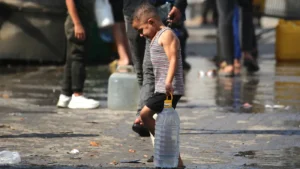Gaza Strip faces a severe water shortage, despite ceasefire

A Palestinian child carries a large plastic bottle filled with water in the Nuseirat refugee camp, central Gaza Strip, on 2 November 2025
Mera Aladam reports in Middle East Eye on 5 November 2025:
The Gaza Strip continues to face a severe water shortage crisis caused by Israel’s two-year genocidal war and the ongoing blockade despite the ceasefire, according to local officials.
Hosni Muhanna, spokesperson for the Gaza City Municipality, said that much of the water currently reaching Gaza amounts to no more than 15 percent of the Strip’s actual needs for its population of over two million – roughly 100,000 cubic metres daily.
During the two-year war, which ended with a fragile ceasefire on 11 October, Israel destroyed most of the wells, and the central desalination plant has been forced out of service. Only 17 wells out of 88 are currently operational.
The Strip is now dependent on the unstable supply from the Mekorot water line, Israel’s national water company. Muhanna said the line provides about 15,000 cubic metres per day.
Even before the war began in October 2023, most water in Gaza was undrinkable due to the Israeli blockade.
In 2020, UNICEF estimated that only 10 percent of the population had direct access to clean and safe drinking water, while more than one million residents – around half of the population – lacked water and sanitation interventions.
Water with high saline levels in several areas across the Strip forces hundreds of thousands of households to buy water for drinking and bathing.
At the onset of the war, then Defence Minister Yoav Gallant – who is wanted by the ICC for war crimes – declared that “no electricity, no food, no water, no gas” would be allowed into Gaza, worsening the crisis. The total blockade was combined with attacks on water networks, wells and desalination plants.
Health officials and local media reported drastic levels of dehydration among many people during the war.
Waste and pollution
